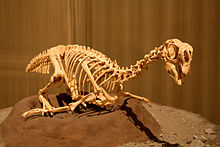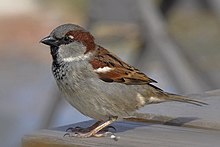Tom.Reding (talk | contribs) m +{{Taxonbar|from=Q4828939}} (0 sig. taxon IDs: 1-time run thru Category:Taxobox articles missing a taxonbar; WP:GenFixes on Tag: AWB |
BrownHairedGirl (talk | contribs) m remove links to deleted portals Tag: AWB |
||
| Line 2: | Line 2: | ||
| name = Pennaraptorans |
| name = Pennaraptorans |
||
| taxon = Pennaraptora |
| taxon = Pennaraptora |
||
| fossil_range = <br>[[Late Jurassic]]–[[Holocene|Present]], {{Fossil range|167|0}} |
| fossil_range = <br />[[Late Jurassic]]–[[Holocene|Present]], {{Fossil range|167|0}} |
||
| image = Conchoraptor in nest.jpg |
| image = Conchoraptor in nest.jpg |
||
| image_caption = Cast skeleton of ''[[Conchoraptor gracilis]]'' |
| image_caption = Cast skeleton of ''[[Conchoraptor gracilis]]'' |
||
| Line 29: | Line 29: | ||
{{Birds}} |
{{Birds}} |
||
{{Fins, limbs and wings}} |
{{Fins, limbs and wings}} |
||
{{Portal bar|Birds|Dinosaurs|Evolutionary biology |
{{Portal bar|Birds|Dinosaurs|Evolutionary biology|Paleontology}} |
||
{{Taxonbar|from=Q4828939}} |
{{Taxonbar|from=Q4828939}} |
||
Revision as of 05:00, 14 July 2019
| Pennaraptorans | |
|---|---|

| |
| Cast skeleton of Conchoraptor gracilis | |

| |
| House sparrow (Passer domesticus) | |
| Scientific classification | |
| Domain: | Eukaryota |
| Kingdom: | Animalia |
| Phylum: | Chordata |
| Clade: | Dinosauria |
| Clade: | Saurischia |
| Clade: | Theropoda |
| Clade: | Maniraptoriformes |
| Clade: | Maniraptora |
| Clade: | Pennaraptora Foth et al., 2014 |
| Subgroups | |
Pennaraptora (Latin penna "bird feather" + raptor "thief", from rapere "snatch"; a feathered bird-like predator) is a clade defined as the most recent common ancestor of Oviraptor philoceratops, Deinonychus antirrhopus, and Passer domesticus (the house sparrow), and all descendants thereof, by Foth et al., 2014.[1] The earliest known definitive member of this clade is Anchiornis, from the late Jurassic period of China, about 160 million years ago.
The clade "Aviremigia" was conditionally proposed along with several other apomorphy-based clades relating to birds by Jacques Gauthier and Kevin de Queiroz in a 2001 paper. Their proposed definition for the group was "the clade stemming from the first panavian with ... remiges and rectrices, that is, enlarged, stiff-shafted, closed-vaned (= barbules bearing hooked distal pennulae), pennaceous feathers arising from the distal forelimbs and tail".[2]
See also
References
- ^ Foth, Christian (2014). "New specimen of Archaeopteryx provides insights into the evolution of pennaceous feathers". Nature. 511 (7507): 79–82. doi:10.1038/nature13467. PMID 24990749.
- ^ Gauthier, J. and de Queiroz, K. (2001). "Feathered dinosaurs, flying dinosaurs, crown dinosaurs, and the name 'Aves'". Pp. 7-41 in Gauthier, J. and L.F. Gall (eds.), New Perspectives on the Origin and Early Evolution of Birds: Proceedings of the International Symposium in Honor of John H. Ostrom. New Haven: Peabody Museum of Natural History, Yale University. ISBN 0-912532-57-2.















